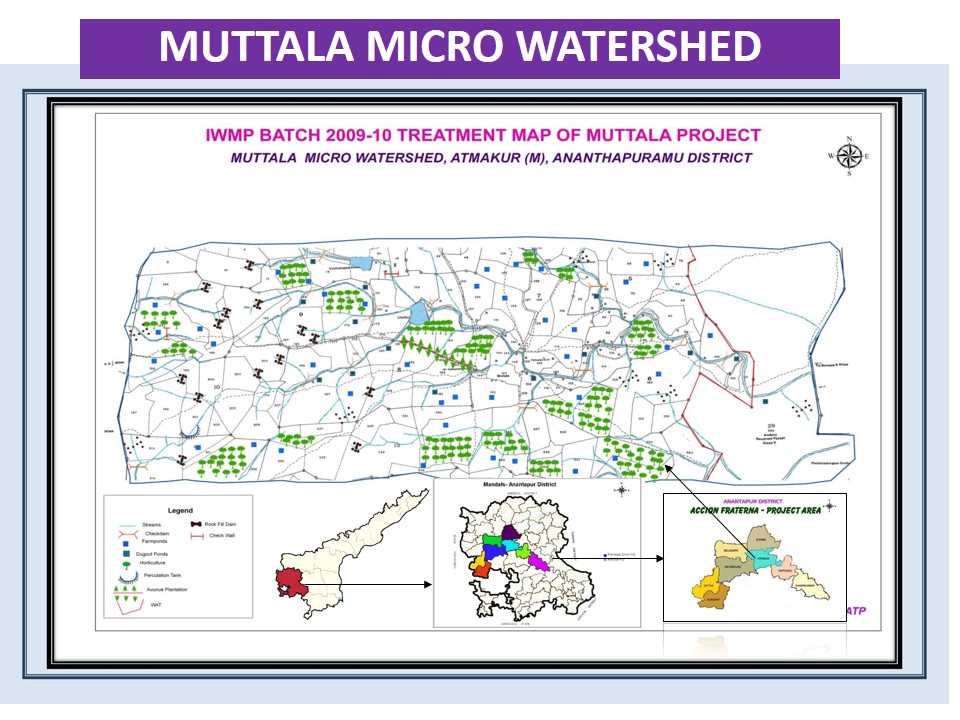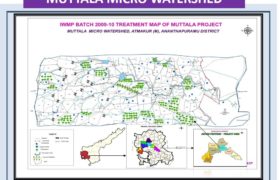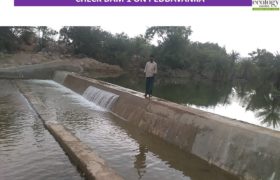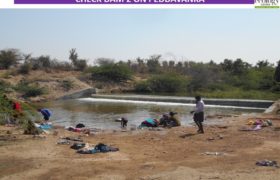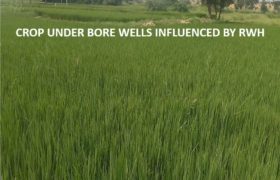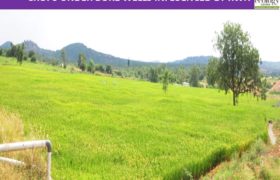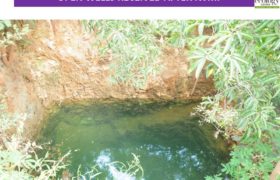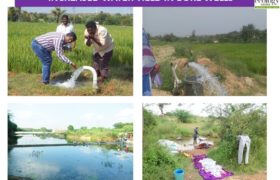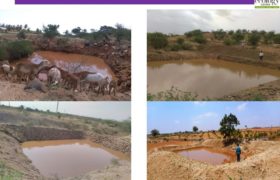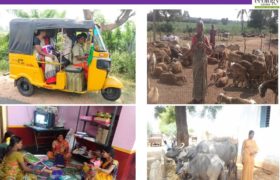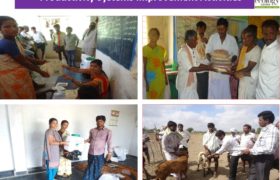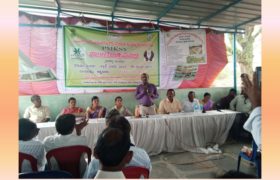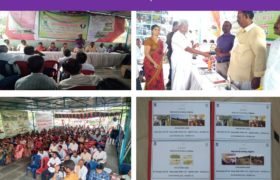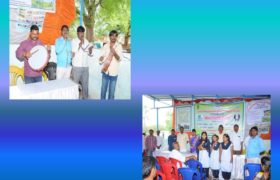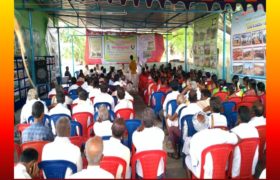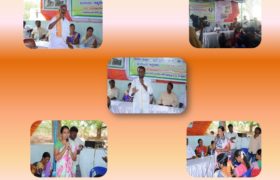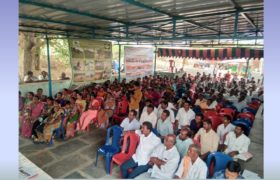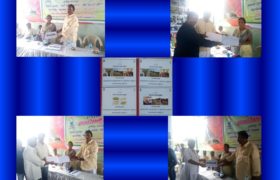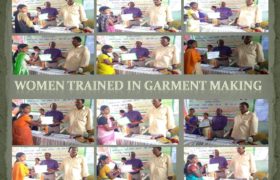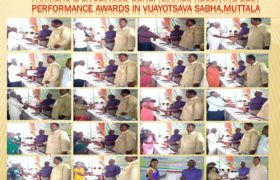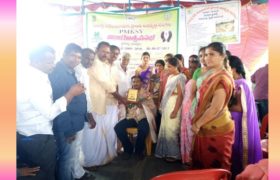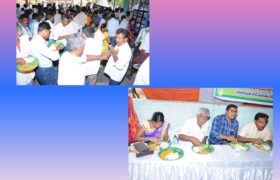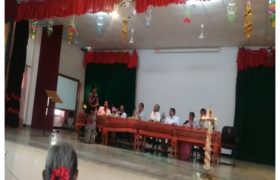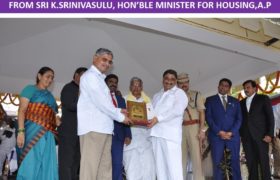
QUOTE: Statement of how the organization Smart and Sustainable Agriculture has influenced his/her life
Our Objectives
- The main objectives of the IWMP are to restore the ecology balance by harnessing conserving and developing degraded natural resources such as soil, vegetative cover and water. The outcomes are prevention of soil run off, regeneration of natural vegetation rain water harvesting and recharging of ground water table. This enables multi-cropping and the introduction of diverse agro based activities, which help to provide sustainable, livelihoods to the people.
Description
1. Introduction:
Accion Fraterna is also implementing Integrated Watershed Development Programme (IWMP) funded jointly by department of Rural development, Govt, of India and Govt. of Andhra Pradesh. The Govt. of India (Ministry of Rural Areas & Employment) have communicated the “common guidelines for watershed development” in the year 2008. As per new guidelines, each watershed covers an area of 2000 to 3000 ha, called ‘Mega Watershed’. Each mega watershed is subdivided into 3 to 5 micro watersheds, depending on the number of villages/ habitations falling within the mega watershed.
Govt. of AP has selected AF Ecology Centre as PIA to implement IWMP Watershed Program and allocated 3 mega watersheds for implementation. They are 1. Muttala (2009-10) in Atmakur mandal 2. Bandameedapalli (2010-11) in Rapthadu mandal 3. Kuderu (2011-12) in Kuderu mandal. Muttala Mega watershed is divided in 4 micro watersheds, namely, Papampally, Muttala, Goridindla, D.K. Thanda. Bandameedapalli mega watershed is divided into 3 micro watershed namely Bandameedapalli, Yerragunta, Varimadugu. Kuderu watershed has 5 microwatersheds namely Kammuru, Kuderu, Antharaganga, Aravakuru, and Kadadarakunta. The period of implementation of each project is 4 to 7years from the date of entering MOU between Govt. of AP and Accion Fraterna as PIA.
Totally an area of 11,808 Ha. Is proposed for treatment in all project villages with a financial outlay of Rs. 14.17 crores.
At PIA level one project officer shall be positioned for 3 IWMP clusters with a team of two technical officers, for each project. The Watershed Computer Center at Project Officer level and computer operator.
- Allocation of funds for various activities under IWMP:
The percentage of allocation for various components within the project outlay is as follows.
(1).Entry Point Activity: 4%, (2). DPR (Detailed Project Report) preparation: 1%, (3). Administration: 10%, (4). Capacity building (CB) 5%, (5) NRM (Natural Resource management) activities works: 56%. (6). PSI (Productivity Systems Improvement): 10%,(7). LH (Livelihoods); 9%, (8). Consolidation: 3%, (9). Monitoring and Evaluation: 2%.
- Process and formation of Watershed Development Committee:
First awareness campaigns are organized on the importance and need of watershed programmes in all the micro watershed villages. The modalities of implementing participatory watershed programme is discussed with the opinion leaders, Community Based Organisation, Gram Panchayath representatives etc. After the village community is prepared for taking up watershed program a Grama Sabha (Village Assembly) is conducted in each of the micro watershed villages. The details of the programme guidelines, and procedures were explained to the villagers, emphasizing the need for conservation and sustainable management of natural resources through “ participatory watershed management”.
The Village Assembly (Gramsabha) has to select the Watershed Development Committee (WDC) members ( 13 to 15), by consensus. At the time of selection of WDC small and marginal farmers, landless poor to SC,ST and women are duly considered so as to involve all sections of the village in the programme.
4. Roles & Responsibilities of W.D.C (watershed Development committee)
(i) The WDC is responsible to implement watershed development activities as per the Detailed Project Report (DRP) in a transparent process ensuring due quality in implementation and in time.
(ii) The committee is headed by a Chair Person, (elected member from among the committee members and by the members).
(iii) The committee meets once in 15 days to review the progress of works and pass resolutions to take up new works, as per the Detailed Project Report.
(iv) The WDC selects, one active unemployed educated youth to work as “watershed assistant” to supervise the implementation of works and report to WDC & PIA periodically.
(v) The WDC undertakes the field visits periodically to ensure the quality and quantity of works.
(vi) The WDC along with V.O.(Village Organization ie., federation of women self help groups) selects the beneficiaries, from poor and families under livelihood enhancement programme component of the watershed.
(vii) The WDC & V.O. are responsible for management of livelihood funds including the recovery of the loans sanctioned to beneficiaries under Livelihood Fund.
- Preparation of DPR and Planning process:
A mega watershed comprises of 4 to 5 habitations or villages covering an extent of 2000 Ha. to 5000 Ha. The entire mega watershed is sub divided into micro watersheds so that the boundary of each micro watershed is coterminous with village boundary as far as possible. However, while demarcating the micro watersheds, drainage line systems, from ridge to valley approach is followed.
5.1 Planning:
In each micro watershed village, PRA(Participatory Rural Appraisal) exercise are conducted. All sections of community participated in the process of PRA exercises to know their natural and social resources through drawing of resource maps of the village.Various natural resources and social structures existing in the village were depicted in the maps. A transect walk was taken up to perambulate the area to assess the land configuration, soil types, existing vegetation etc.,.After collecting information net planning was taken up.
A team consisting of 10 local educated youth was engaged to conduct household socioeconomic survey in the formats provided and data computerized. Later survey holding wise net planning was with involvement of each farmer in order to decide the location specific interventions to be taken up to improve the productivity of rainfed farm lands. The data collected during net planning, was computerized to arrive at financial implications. Also, a plan for other livelihoods is also prepared for 5 years. A detailed project report is prepared for taking up soil and moisture conservation works, rain water harvesting structures, dry land horticulture, vegetation improvement works, etc., The unit cost of treatment per Ha. is Rs.12000/- . If the planning exceeds the total budget under IWMP, the plan outlay takes into account the MGNREGS funds to make a total watershed development plan. Thus each micro watershed development takes into account both IWMP and MGNREGS funds. For NRM works the programme is heading to words grounding of works/interventions.
- Payment system for implementation of activities :
The payment for works in the watershed programme is done through EFMS ( Electronic Fund Management System). For this purpose, one W.C.C (Watershed Computer Centre) is set up at head office of AF and the WCC is linked on line to SLNA (State Level Nodal Agency) Vijayawada, from where the payments will be made directly into bank accounts of beneficiaries (Skilled & unskilled thorough labour or suppliers) after thorough on line verification of muster rolls & M – Book. Through this system, progress of works & expenditure of each watershed is captured instantly by State Level Nodal Agency every hour.
This system is highly transparent with regard to financial transactions of the programme as anybody can have access to website to know the implementation of the programme.
Table showing the expenditure particulars of IWMP watersheds as on 12-08-2019
S.N | Name of the watershed | Area planned for treatment (Ha) | Area treated | Project cost in lakhs | Expenditure Rs.in lakhs | No.of farmers benefited | No.of labour families benefited | No.of person days of employment generated |
1. | Muttala | 2535 | 2535 | 304.20 | 823.95 | 1283 | 5601 | 369194 |
2. | B.M.palli | 4942 | 2967 | 593.04 | 1109.45 | 1379 | 4917 | 464903 |
3. | Kuderu | 4331 | 2362 | 519.72 | 1364.85 | 669 | 3784 | 739992 |
| Total | 11808 | 7864 | 1416.96 | 3298.25 | 3331 | 14302 | 1574089 |
- User Groups:
User groups of farmers within the watershed are formed to inculcate a sense of ownership and responsibility among smaller groups over the programme components. Farmers within an area of 100 to 120 Ac, are formed into a group called “ User group” Sometimes affinity groups are also formed who can take up same type of activity (For example, Dry land horticulture , fodder development etc.,) Each member of group will save an amount of atleast Rs.50/- per month. The User Group members meet regularly to discuss about the watershed works taken up within their farm lands. The SLNA sanctions matching grant to the user groups to take up purchase of implements, seed etc., The following table gives the information of U.Gs and savings in Mega watersheds.
Sl.No | Name of Megawatershed | No.of U.G’S |
1 | Muttala | 44 |
2 | Bandameedapalli | 45 |
3 | Kuderu | 98 |
Best performance PIA Award:
AF is implementing the IWMP Projects giving high priority to participatory approach. Recognizing the efforts of AF in implementing the projects, the state level and district level administration awarded “ Best Performance Award” consecutively, from 2009 to 2012. Muttala watershed is a model watershed, which is being visited by many PIAs from across AP and Telangana States in order to emulate the processes of participatory watershed development.
Best performance PO award: PO best award district collector and minister Raghuvera Reddy 2014 January 26th given to best performance award.
- Watershed Development Fund (WDF):
An amount equal to 5% of the total cost of the works taken up each in farmers land will be contributed by the farmer to WDF. This fund will remain with the WDC, which will be used for post project maintenance of the assets created.
- Activities taken up under Watershed Development:
- Entry Point Activity (EPA): The most commonly felt need of the community would be taken up as an EPA, like access to safe drinking water n the village is one such activity. Water purification (Reverse Osmosis), plants are constructed in every watershed village. Along with water purification plants in all villages
Cattle water troughs are constructed to quench the thirst of animals and small ruminants.
The EPAs are to bring together different sections of people in a village and practice to take decisions in a participatory / consensus approach and also to bring the PIA and the village community on the same page.
- Treatment of Ridge portions:
Continuous or staggered contour trenches on ridge portions impound rain water to improve moisture in upland areas, and promote natural regeneration of vegetation, besides recharging ground water downstream side.
- Afforestation in hillocks:Planting the upland hilly areas with fodder, fruit and drought hardy biomass species and conserving natural regeneration arrests soil erosion and serve as carbon sinks.
The commonly planted tree species are ______________________________
- Treating the drainage lines:Treating the drainage lines with rock fill dams, Gabion structures, loose boulder structures across the first order streams to harvest and reduce the speed of water thus increasing base flows in the drainage system and preventing further deepening of gullies.
- Farm Ponds:Farm Ponds are constructed at the depression point of lowest contours in rain fed agricultural land holds in order to collect rain water which can be used to provide life saving irrigation to rain fed crops during the long dry spells. The inner sloping sides of the farm pond and the bottom are to be lined with cement mortar, in order to present seepage and store for longer period so that it can be used for life saving irrigation.
- Dry land Horticulture (DLH):It is an assured income yielding intervention in drought prone areas, like Anantapur district. Farmers in watershed villages have undertaken this activity in large extents of raifed areas.
- Check Dams:Constructed across stream flows to impound rain water that can stay for 5 to 6 months. Check dams are very useful to increase ground water and rejuvenate the base flows in streams, during summer season. The bore wells in the vicinity of check dam are rejuvenated to give assured irrigation to crops. The check dams are also providing water for cattle, wild animals, birds etc and for washing clothes.
- Block plantations in village community lands:Block plantations are raised in village community lands they will increase the greenery and biomass and also help in mitigating the climate change. The plantations raised with species like jamun, neem, tamarind, will yield income to village panchayaths.
- Percolation Tank:The percolation tanks are meant to harvest the rain water over a large area, and ground water recharge capability is very high. The bore wells situated in the influence zone of a percolation tank, yield ground water sustainably to irrigate the agricultural crops.
- Raising of fodder Plots: Raising fodder plots are one of the important activities. Many farmers with irrigation facility set apart at least 0.5 Ac. To 1 Ac. of land to grow fodder feed the milch animals, and other small ruminants, to promote milk production through raring of milch animals.
- Livelihood Activities for the landless and poor:Landless and poor would undertake non-farm income generating activities like raring of milch animals, Auto transport, tailoring etc.,. There is is provision for landless poor to take up income generating activities under watershed development programme. Beneficiaries receive loan from a revolving livelihood fund and repay the same in equal monthly installments with a nominal interest.
- Productivity Systems Improvement (PSI ):Productivity Systems Improvement components include procuring farm implements like tillers, cultivators, grass cutting machines, sprayers, etc., Funds are earmarked towards subsidy(50%), and loan portion to provide farm implement packages to user groups, in coordination with A.P.Agro Industries corporation. Custom Hiring Centres are also established under PSI.
Table showing l particulars of Livelihood activities under IWMP watersheds
S.No. | Name of watershed | Livelihood amount released (Rs.) | Amount loaned (Rs.) | No. of Families covered |
1. | Muttala | 2738000 | 2738000 | 162 |
2. | Bandameedapalli | 4135000 | 4135000 | 188 |
3 | Kuderu | 4653000 | 4653000 | 186 |
| Total | 11526000 | 11526000 | 536 |
Consolidated progress under IWMP watershed projects as on 12-08-2019
S.No | Activities | Beneficiaries | Extent Ac/Rmts/Km |
1 | Boulder removal | 13Nos | 52Ac |
2 | Staggered Trenches | 18 Nos | 155 Ac |
3 | Water Absorption Trench | CPR | 16000 Km(500 Ha) |
4 | Loose boulder Structures | 1 Nos | 1 Ac |
5 | Rock Fill dams | 308 Nos | 328 Mts (785 Ac) |
6 | Farm ponds | 1021 Nos | 2552 Ac |
7 | Dugout ponds | 407Nos | 2185 Ac |
8 | Percolation Tank | 7 Nos | 125 Ac |
9 | Check Walls | 16 Nos | 250Ac |
10 | Check Dams | 71 Nos | 1420 Ac |
11 | Repair of Existing P.T’s | 5 No | 75 Ac |
12 | Desilting in Check Dams | 01 No | 25 Ac |
13 | Repair of Exisiting CD’s | 45 Nos | 112Ac |
14 | Avenue plantations | CPR 15 Nos | 15 Km |
15 | Barren Hill Afforestation | CPR | 5 Ac |
16 | Block Plantation And Private Lands | CPR 15 Nos | 81 Ac |
17 | Nursery | CPR | 78000 Nos |
18 | Dry Land Horticulture | 1083 Nos | 3630 Ac |
19 | Fodder Plots | 69 Nos | 50 Ac |
20 | Machine Farm Ponds with Farm Bunds | 17No’s | 85 Ac |
21 | NADEP Compost | 229 | 573 Ac |
22 | Threshing Floors in Community lands | 10Nos | 1500Ac |
23 | Seed Dibbling | 13Nos | 250Ac |
24 | Greening of Hillocks | 6 | 187.5Acs |
25 | Cattle Troughs | 10 | Community Local Animals |
Associate Organisations / Donors


Our Project Areas
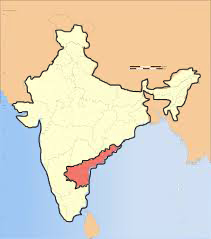
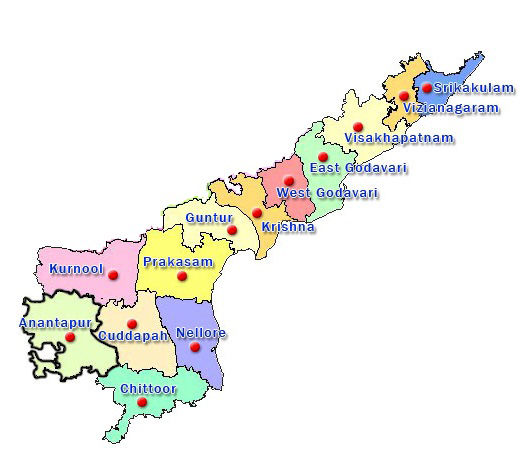
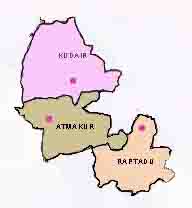
- Atmakur
- Rapthadu
- Kuderu
